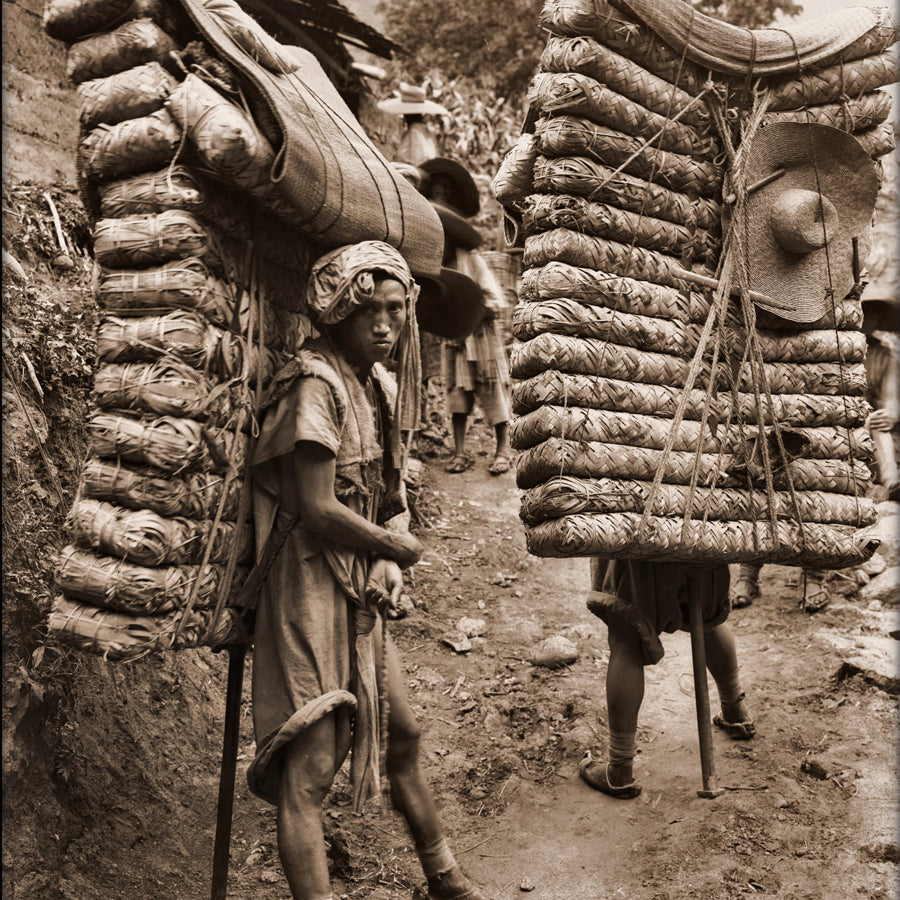
The road to the best tea in China
Share
The Tea Road – The Soul of Porters and Caravans
The Tea Road (茶马古道 – Ancient Tea Horse Road) is one of the most fascinating routes in Chinese history. Long before trains and trucks crisscrossed the country, tea especially Yunnan Pu-erh—traveled on the backs of humans and animals, crossing mountains, valleys, and rivers to reach Tibet, Sichuan, and, even further, Central Asia.
While stories often highlight the caravans of yaks, ponies, and mules that carried impressive loads of compressed tea, the lesser-known but equally essential story is that of the tea porters, the men, women, and sometimes children who lent their shoulders and their lives to this vital trade.
Tea porters in Luding en route to Kangding, late Qing dynasty. Source: Baidu.
Tea Porters: Lives Bent Under the Weight
The roads were narrow, steep, and dangerous. When the animals could no longer move forward, only the porters took over. Their T-shaped wooden frames resembled "a dragon's back," as a local saying went: "Out of ten porters, nine are poor, and their bent loads resemble a dragon's spine."
Children as young as thirteen entered this profession out of necessity. The strongest carried up to 150 to 200 kilos of tea, compressed into cakes or rolls, walking for days on end wearing simple straw sandals. Men, women, and even mothers with their infants participated in this superhuman ordeal. Each journey between Nitou and Kangding could last up to ten days.
Their pay was paltry: a handful of corn, a few yuan, sometimes a meal exchanged for several rolls of tea. And yet, for these landless peasants, it was the only way to survive.
Tea Porter, 1929. Photo: David Crockett Graham. Source: Baidu.
The Price of Tea: Sweat, Blood, and Bones
The Tea Road was not only a trade route: it was also a path of suffering and sacrifice. At Gale Winds Bay (大风湾), icy winds could sweep porters into the void. A gloomy pit, nicknamed the White Bone Pagoda (白骨塔), served as a communal burial ground for those who perished along the way.
At night, the porters slept under rocks, covered in rags, eaten alive by fleas and mosquitoes. Their meals consisted of bland tofu soup or cornmeal, seasoned with salt. Some smoked opium to numb the pain. Despite this, brotherhood, fortitude, and perseverance bound them together.
Tea Porters. Early Republican Period. Source: Baidu.
A Living Memory of Tea China
At the beginning of the 20th century, with the arrival of the railway and modern roads, the role of porters declined. Yet their story remains a symbol of an era when the tea trade relied on human strength. In 2002, one of the last porters, Li Guangrong (李光容), aged 82, still recounted how he had spent his entire life carrying heavy loads of tea between villages and markets.
Today, the Tea Road has entered the collective imagination as a major cultural heritage. It reminds us that each cup of Pu-erh or vintage tea is not only the fruit of a terroir, but also that of generations of men and women who, through their sweat and sometimes their lives, have allowed tea to travel and become a universal art.
Qingxi Township, Hanyuan County, Sichuan. Source: Baidu.
Heritage and Passion for Pu-erh
At Lemeilleurthédechine, we honor this history. Each Pu-erh cake, each vintage tea we offer, bears this ancestral story, traversed by mountains, effort, and memory. Tasting these teas is not only to savor unique aromas, but also to reconnect with the spirit of the Tea Route, this path of trade, culture, and resilience.
Men_Laden_With_Tea,_Sichuan_Sheng,_China_1908_Ernest_H._Wilson_RESTORED
Sources: – Revisiting the Ancient Tea Horse Road (又见茶马古道), edited by the Ancient Tea Horse Road Editorial Committee, Beijing: Minzu Chubanshe, 2004:56-58.
– Liu Yong (editor), ‘Porters Along the Ancient Road,’ in The Ancient Horse Tea Road, Hefei: Shidai chuban meiti gufen youxian gongsi, 2012: 33-36
–– Water Politics and Religious Practices in Kangding,” in Himalaya: the Journal of the Association for Nepal and Himalayan Studies, volume 37, number 1, June 2017:117-118.
– https://blog.tranquiltuesdays.com/post/34563836358/puer-and-the-ancient-tea-horse-road
– https://fr.wikipedia.org/wiki/Ancienne_route_du_th%C3%A9
– https://teahorseroadproject.wordpress.com/2017/10/20/tea-porters
– https://teahorseroadproject.wordpress.com/2017/10/31/tea-porters-2/
– https://www.tranquiltuesdays.com/resource-library/ancient-tea-horse-road-heritage
Have a good trip!




